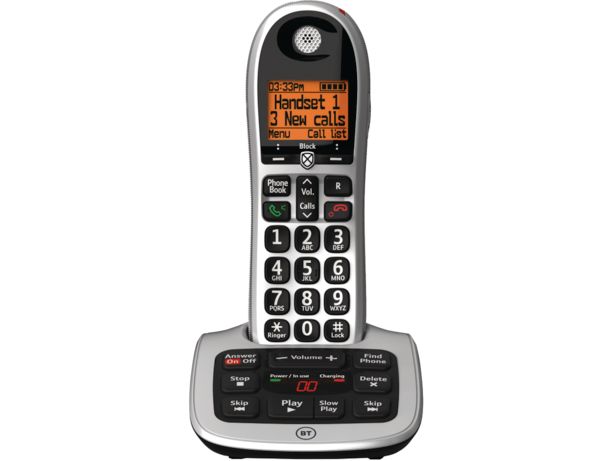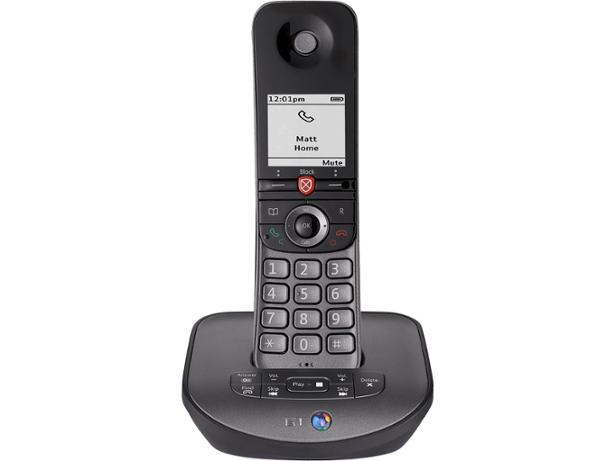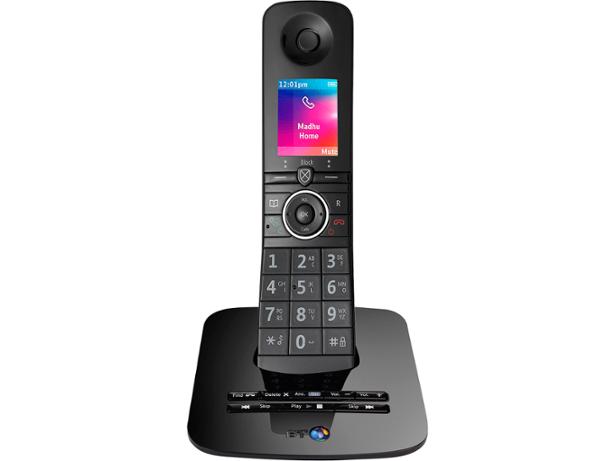If you're sick of cold callers, there are technological solutions to limit how many you'll get on both smartphones and home phones.
Fortunately, none of these solutions are too difficult to implement, and each should see a dramatic drop in nuisance calls in a short period of time.
Read on to find out how they work and what they can do.
Read our guide on the best cordless phones to get more tips, advice and recommendations around home phones.
Best call-blocking home phones
One of the most effective solutions for blocking nuisance calls on a landline is a good call-blocking home phone. We've highlighted three great call-blocking cordless phones below, all of which also offer fantastic call quality and excellent cordless coverage.
Remember, for any call-blocking phone to work you’ll need to activate your Caller ID with your landline network provider.
- BEST BUY
Dialing is a doddle with the Best Buy BT 4600, due to its extra-large, tactile buttons and sizeable screen, which has good contrast between the black text and orange background. It has great call-blocking features including a virtual secretary to screen your calls. It’s simple to set up, the ring volume is loud and this home phone is compatible with digital hearing aids. Calls sound clear, but it also has an amplify button to boost the volume when you need it.
Read full review- BEST BUY
This well-equipped Best Buy phone has sophisticated call-blocking features that can put a stop to nuisance calls. You can save up to 200 numbers in the phonebook – these will be put straight through to you – and block up to 1,000 that you don't want to hear from. The phone's range is excellent and the handset will sound an alarm if you start to wander too far, giving you the chance to return to an area of stronger coverage before you're cut off.
Read full review- BEST BUY
BT’s top-of-the-range phone is packed with features, from Bluetooth connectivity so you can easily add your mobile contacts, to fantastic call-blocking options. It does the basics well too. Calls are clear and the ringers, in both the base unit and the handset, are very loud. The phone’s signal strength is among the best we've seen, so you're unlikely to be cut off if you wander around the house while you're speaking.
Read full review
All pricing, recommendations, and test scores are correct as of January 2023.
Not found the product for you? Browse all of our independent cordless phone reviews.
Blocking calls using your home phone provider
Most of the major landline phone providers now offer a free service to reduce the number of nuisance calls that you receive. Here’s what’s on offer from the biggest providers:
BT
BT’s Call Protect automatically diverts calls that BT believes to be from nuisance callers to customers' junk voicemail boxes, and it also allows people to compile a personal blacklist of numbers they wish to block. You can then supplement this by sending all calls from certain types of numbers (international, withheld and unavailable) to the voicemail service.
Call Protect is a much more powerful tool than some of BT’s other call features, such as Choose to Refuse, which only lets you block 10 specific numbers, and Anonymous Call Rejection, which just stops calls from people who have withheld their number. And while you have to pay for both of these (£5.50 and £7.50 per month, respectively), Call Protect is free. So if you’ve not signed up for it you should do so, especially if you’re wasting money on the other two inferior options.
Sky
Sky customers can benefit from Sky Talk Shield, the network's personalized call screening service. Talk Shield intercepts and blocks call from ‘robots’ and automated callers, while live callers to your phone are asked to identify themselves. When you then answer the phone, you’ll hear a recording of this – you can then accept the call, add the caller to your Star or Block List, or send them to voicemail. Add up to 1,000 numbers while on a call, after a call, or online.
Callers on your Star List, such as your friends and family, will get straight through every time, while numbers you block will never bother you again.
TalkTalk
TalkTalk’s free call-blocking feature is called CallSafe. It works in a similar way to Sky’s Talk Shield, asking callers to record their names so you can decide whether you want to talk to them. Calls from frequently dialed numbers or those on your approved list are automatically connected, while those on your blocked list or in CallSafe’s database of unwanted calls are automatically blocked.
Virgin Media
Virgin doesn’t have anything as advanced as the three other big phone providers. Instead, its customers have to rely on its more limited anonymous caller-rejection feature, which only blocks calls from withheld numbers. And you have to pay around £3 per month for this.
Blocking calls with a standalone device
If you don't want to replace your home phone and your provider can’t block the nuisance calls you to receive, then another option is to buy a separate call blocker and plug it into your existing device.
These usually work in the same way as the call blockers built into phones, in that they have a ‘black list' of numbers or number types, and stop any incoming calls from them. But the TrueCall call blockers are a little different, using the same technology licensed to some BT phones and embraced by Sky and TalkTalk, to screen out unwanted callers.
Blocking calls on your smartphone
All modern smartphones let you block specific callers. If you have an Android or iPhone handset you can add numbers to a blocked list, reject unknown callers altogether or set a ‘do not disturb’ mode that only allows calls from certain numbers.
Call blocking on an iPhone
To block specific numbers simply go to your list of recent callers (open the Phone app, then hit the Recents tab at the bottom).
Click I symbol next to the unwanted number, scroll down, and tap Block this Caller, then confirm your decision. You won't be bothered by any calls, texts, or FaceTime calls from that number.
Alternatively, go to the Settings app, scroll down, and tap Phone. Tap Blocked Contacts, and you'll see your list of blocked callers. Hit Add New and pick further numbers to block from your contacts list. You would need to add the nuisance caller to your contacts list for this method to work, however.
If you have iOS 13 or later, to stop calls from people you don’t know you can turn on a feature called Silence Unknown Callers. This is also done in the Settings app. Go to Settings > Phone, scroll down, then select Silence, Unknown Callers.
This blocks phone numbers that you've never been in contact with, don’t have saved in your contacts list, and haven't received their number another type of way, such as through emails. Calls from unknown numbers are silenced and sent to your voicemail, and appear in your recent calls list. If you make an emergency call, this is suspended so you can receive any calls for 24 hours.
You can also set up a third-party app to filter and detect spam calls. Go to the App Store and download an app that detects and blocks spam calls. Always be wary when downloading third-party apps, and don't agree to any terms and conditions that feel unusual.
To allow the app to block spam calls, go to Settings > Phone > Call Blocking & Identification. Turn the app on or off under Allow These Apps to Block Calls and Provide Caller ID. When you receive a call, your device compares the number with the list of numbers in the third-party app. Your phone will then show an identifying label chosen by the app, such as 'Spam' or 'Telemarketing'. If it's spam, the app may block the call automatically.
Call blocking on an Android phone
Whether you answered the call or ignored it, all calls are registered in the recent tab of the Android Phone app. Launch the app by pressing the Phone icon, touch the Clock symbol to show your call history, then navigate to the number you want to block. Touching it will bring up a short menu, enabling you to choose to block it.
Once you’ve blocked a number it will appear in your blocked numbers list, accessible by tapping the three dots at the top right of the phone screen and choosing Settings > Blocked numbers. You can also manually add a number you wish to block within the Blocked numbers page.
Interested in a new smartphone? Check out our mobile phone reviews or explore the best mobile phone deals we'd recommend.
More top tips to stop nuisance calls
Even if you take the steps above to prevent nuisance calls, some can slip through the net. The latest figures from the telecoms regulator Ofcom showed that 43% of people in 2019 received a nuisance call on their home phone in the last month. That’s actually an improvement – back in July 2015, the proportion was a shocking 73% – although it still shows the extent of the problem. Read on to discover our top tips for reducing the number of annoying calls that you receive.
1. Register for free with the Telephone Preference Service (TPS)
Registering with the Telephone Preference Service (TPS) is the UK's only official 'Do Not Call' register. Registering with them should reduce the amount of unwanted sales and marketing calls you receive. Register with them by visiting its website (tpsonline.org.uk) or over the phone at 0345 070 0707. The TPS is free to use – if a company ever asks you to pay for this service, then refuse and inform the TPS.
On the whole, the TPS is very effective, and reputable organizations and businesses take it very seriously because it’s a legal requirement that companies do not make calls to numbers that are registered. But some still flout these rules. Also, the TPS only applies to UK-based companies making unsolicited sales and marketing calls – it doesn’t apply to market research calls, calls from companies where you have 'opted in', or calls from companies based abroad.
2. Keep your name off sales call lists
Some companies may use online or paper phone books to find numbers to target with sales calls. Ask for your phone number to be excluded from directories – this will stop companies from finding out your number in this way.
If you must provide your phone number to a company, then ask it not to call you for marketing purposes or to pass your number on to third parties. And carefully check the marketing 'opt out/opt in' boxes when providing your contact details on forms. Finally, contact companies you already receive unwanted sales calls from and ask to be removed from their call lists. Companies should abide by verbal requests, but it’s a good idea to put your request in writing, too, so there is a formal record.
3. Screen your phone calls
If you have a caller display and an answer phone, consider only answering calls from numbers you recognize. Legitimate callers are likely to leave a message.
4. Report cold-calling offenders
It’s important to report nuisance calls so that the offenders are identified and punished. But the body to contact varies depending upon the type of call. Report live sales and marketing calls to the TPS (assuming you’ve already registered your number with it), while silent calls should be reported to Ofcom and scams to Action Fraud
Find out more in our guide on reporting nuisance calls. If you’ve seen or been affected by what you think is a scam, sharing the details can help us inform others about them and what tactics scammers might be using to mislead consumers. Report this using the Which? Scam Sharer tool.
Article Source: Which.co.uk








Comments